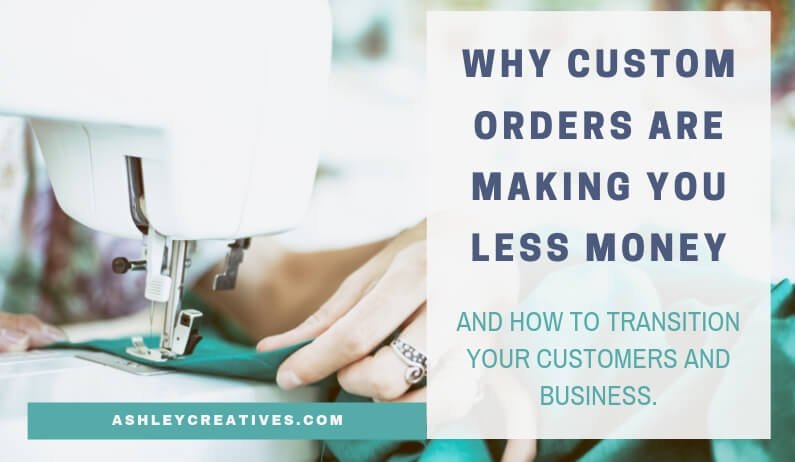When I talk to handmade business owners, one of the most common complaints I hear is about how time consuming custom orders are. They are often surprised to learn that I don’t accept custom orders. Many of them would like to transition away from so many customs but aren’t sure it’s possible.
Not only is it possible, it rapidly become necessary in many growing businesses. Let me show you how custom orders may be limiting your business. And then I’ll tell you how to get your business back on track to grow and thrive.
What Are Custom Orders?
Custom orders are any type of order that comes in from a customer and requires you to create based on what the customer wants. Orders can have slight customization in that they need a different paint, or stain, or fabric, or gemstone. But the general design or pattern is the same.
Orders can also be completely custom. This would be a product that needs to be designed, approved, and created from scratch based on the customer’s desires.
What’s Great About Custom Orders?
Many of us, myself included, started our businesses by taking mostly custom orders. It’s a way to grow and grow quickly. We offer the customer anything they want to get the sale. It’s common to start off this way because you as a business owner probably do not have a loyal following, yet.
You may not really know what products people want. It can take time to know what your target market is truly looking for. So as newbies, we jump at the chance to make any money for this baby business that we are trying to get off the ground.
So custom orders aren’t all bad.
- Custom orders can benefit our business by offering a local following exactly what they want.
- Customs are also a good way to find out what things your target market is looking for.
- Customs can grow a customer base of people that recommend you and your product.
Why Are Custom Orders a Problem?
Even though there are some good things that can happen with your business because of custom orders, at some point they become a problem. It’s usually after you’ve been in business for awhile and are ready to grow to the next level that you may find yourself dreading custom orders. Why?
1. Communication Burnout
Think about how much time during a custom order is spent on communication. A typical order might have the customer messaging with interest or to find out if you can create an item for them. You will likely be messaging back with questions. This can go on and on. You will need to message about price, a timeline for completion, pickup info, approval of design, and approval of final product.
Conversations like these are going back and forth a ton depending on how much customization you are offering. It’s time consuming. And often you aren’t calculating the time in the cost of the item. Most sellers seem to count this as the cost of acquiring the order.
But what happens when you add up the time difference of making items without customization compared to a custom order? You may find you are working for a lot less money than you thought.
2. Design time
Custom designs are supposed to be exactly for one person. They may or may not be something that anyone else would ever like to purchase. You need to get approval of the design and sometimes this requires redesigns.
“Can you make that part a little smaller?” “What if I want to add this instead?” “Never mind. I liked it better the first way.”
And there’s a good chance you might never make that design again for anyone. Some sellers who work primarily on custom orders will include a design charge and a limited number of edits to that design. But many sellers don’t. They just lump the design time, like the communication time above, into the cost of getting the order.
But it lowers how much they are making. And on some custom orders with difficult customers, it can make a profit nearly non-existent.
3. Getting paid
And it is possible after all the communication and designing to not get paid at all? “Oh, well I’ll think about it and let you know.” All after you had settled on what was to be made, but before you got paid anything? It puts a sick feeling in your stomach when this happens. And chances are it has happened or will
happen to you if you do custom orders.
And even if they don’t change their mind before you start, after all of that communication, all of that design time, often we still have people who don’t want to pay until the item is complete.
DO NOT ALLOW THAT TO HAPPEN.
You need to be paid up front for your customs. Why? Because if you don’t, you will be working for free. Actually it’s worse than working for free. Materials aren’t free. And your time is worth money and you can’t discount that. And what about the time spent chasing down the money from people? Well? Are you going to figure that into your cost of doing business, too? Pretty soon it feels like you are paying them to shop from you.
Customers show that they are serious when they pay. Require that custom orders be paid for in advance. This isn’t something new for people. Most businesses require money before they compete work. And you are a business.
4. Arranging pickup
Raise your hand if you ever feel like you’ve sent messages practically begging people to pick up their stuff. Say “amen” if you have an area of your home or shop where people’s items collect dust waiting for them to have enough time to pick up.
This happens even when they’ve paid for it. Custom work inevitable makes you into an unpaid storage unit for products. And it takes time to send reminder emails and messages.
Why Are Designs That Can Be Resold Better?
1. No need for approval. You research. You decide options. You create what you know your people want. It’s freeing to not have all of that communications needed back and forth. You get to be what you love. You are a creator. You are an artist. Anyone can send a message but only you can create something amazing. And you don’t have to get permission from someone else for it. You get to be a boss.
2. If the design does take off, it’s already designed. You don’t have to redesign each time. Designing time can be tedious. But if you design it once and then have it ready to go for future orders it saves you time. Time you can be creating product that brings in money.
3. Pictures for listings. The items you create can be used for really great pictures and allow others to order. You create an already designed piece as orders come in. You can use one item to create listings for Etsy, Amazon, your website, and social media. And you can get orders from all of them on a design that is ready to go and has been perfected by you.
How To Transition To Fewer or Even Zero Custom Orders?
I know some of you are thinking, “Okay, that’s all well and good. But I do mostly customs. And I need money. How can I get off this customs wheel and still eat?” This is a smart question.
The amount of custom orders in your business currently will determine how slowly you can transition away from orders. If they are 100% of your business and you are swamped with orders, it will take time. You need to find a way to create new designs that you’ve come up with as well as stay up on your custom orders.
1. Make an announcement.
Tell your customers something to the effect of…
“I am so blessed by all of you. My business has grown so much that I am going to be limiting my custom orders to ____(insert a number of orders) each __________(insert a time frame week, month, quarter). Once those slots fill up I won’t take any more customs until _____(next time you might open for customs).
This does 2 things.
- It creates a sense of urgency for those who’ve been thinking “I should order a custom from ____(your business name.)” Now they have to hurry and get their order in or they might not be able to.
- It allows you to generate some income right now and give yourself a cushion to create some other products in the next couple of weeks for a live sale, to list on Etsy or Amazon, or to create for a restock in a Facebook group.
2. Limit customs, but slowly.
Keep making this announcement each month or quarter as the customs fill up. If someone private messages you about a custom order and you have the time and space to do it, add it to the list. If not, tell them your customs are filled for the month but you will open back up for 10 customs on the first of next month (or whatever you have decided is best for your business.) Encourage them to check your business page or website for the announcement and to sign up then.
Over time as you get more sales from your non-custom pieces, continue to lower and lower the amount of customs you are willing to take on. “We only have room for 5 custom orders this month. I’ll take the first 5 that sign up.” Until you are able to make the announcement that because of how much you’ve grown you are no longer doing custom orders. Then celebrate! You did it!
3. Keep up with trends and offer the things they want.
It’s essential that the things your customers and target market are loving and searching for are the same things you are creating. Stay up with trends. Know through the things you post and the things they react to what customers will be thrilled to see you make and offer for sale. Use a Facebook group to sell and create frenzy around your product.
Start an Etsy or Amazon Handmade shop to create more opportunities for them to shop from you. And if someone messages you with a custom order that would be something ideal to design and offer to the rest of your customers you can decide if you want to take it or not. Because you have created the freedom in your business to make that choice.
Custom orders definitely have their positives, but for many growing businesses custom orders don’t pay as much per hour as non-custom orders. It can take some time to transition your business, but the benefit is increased sales and freedom. It creates more sales and an increase in the ability of your business to be run by you instead of you being run by those custom orders.
Want to save this to read or share later? Pin this!





